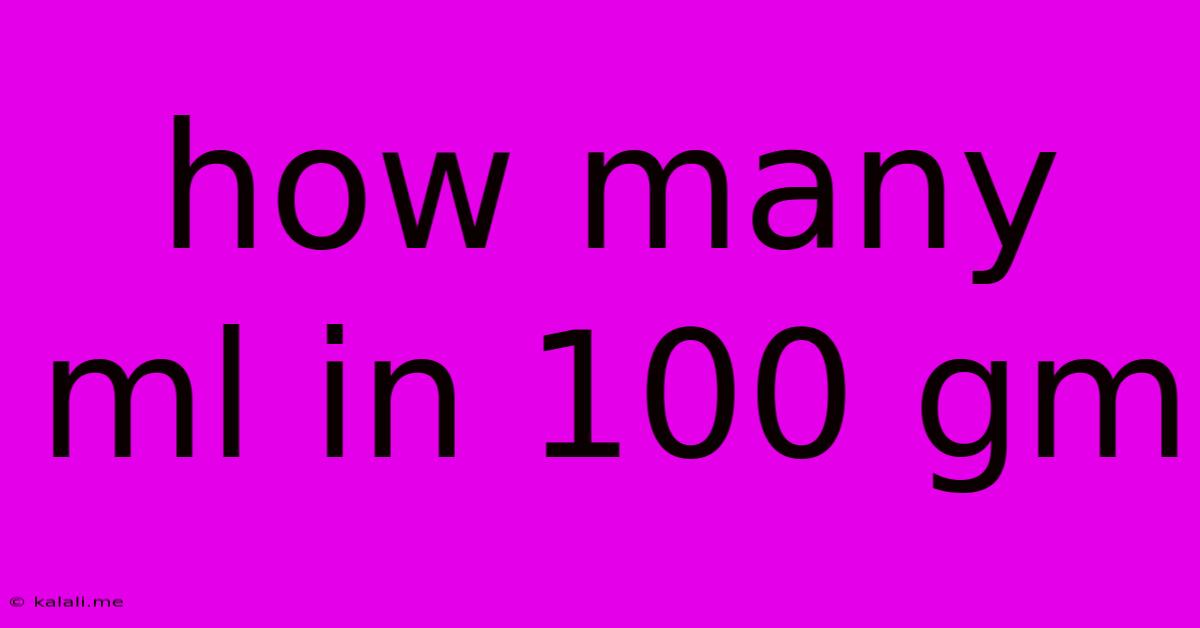How Many Ml In 100 Gm
Kalali
May 21, 2025 · 2 min read

Table of Contents
How Many ml in 100g? Understanding Volume and Weight Conversions
Knowing how to convert grams (g) to milliliters (ml) is crucial in cooking, baking, and various scientific applications. It's important to remember that this conversion isn't a simple, universal calculation. The conversion factor depends entirely on the density of the substance you're measuring. Density is the mass per unit volume, often expressed as g/ml or g/cm³. Water, for example, has a density of approximately 1 g/ml, but other substances will have different densities.
This means there's no single answer to "how many ml in 100g?" Let's break down how to perform this conversion accurately for different substances.
Why You Can't Directly Convert Grams to Milliliters
Grams measure mass – the amount of matter in an object. Milliliters measure volume – the amount of space an object occupies. Two substances with the same mass can occupy different volumes if they have different densities. A kilogram of feathers will take up significantly more space than a kilogram of lead, even though their masses are identical.
Calculating the Conversion: The Density Factor
The key to converting grams to milliliters is the density of the substance. The formula is:
Volume (ml) = Mass (g) / Density (g/ml)
Let's illustrate with a few examples:
-
Water: As mentioned, water has a density of approximately 1 g/ml. Therefore, 100g of water is approximately 100ml.
-
Milk: The density of milk is slightly higher than water, approximately 1.03 g/ml. To find the volume of 100g of milk, we'd calculate: 100g / 1.03 g/ml ≈ 97 ml.
-
Oil: Cooking oils generally have a density lower than water, around 0.92 g/ml. For 100g of oil, the calculation would be: 100g / 0.92 g/ml ≈ 109 ml.
The Importance of Knowing the Density
It's crucial to understand that these are approximations. The density of substances can vary based on factors like temperature and purity. For precise conversions, you need to know the exact density of the substance at the specific temperature you're working with. This information is often available in scientific databases or material safety data sheets (MSDS).
Practical Applications and Considerations
Accurate gram-to-milliliter conversions are important in many fields:
-
Cooking and Baking: Recipes may specify ingredients in either grams or milliliters. Accurate conversion is essential for consistent results.
-
Chemistry and Science: Precise measurements are critical in experiments and formulations.
-
Medicine: Dosage calculations often require converting between mass and volume.
In Conclusion: There's no universal answer to "how many ml in 100g?" The conversion depends entirely on the density of the substance. Always use the appropriate density for accurate results, especially when precision is critical. Remember to always consult reliable sources for density information.
Latest Posts
Latest Posts
-
How To Remove Oil Stains From Walls Without Removing Paint
May 21, 2025
-
Spark Plugs Are Black And Sooty
May 21, 2025
-
How Long Does It Take For Glue To Dry
May 21, 2025
-
I Have Ran Or I Have Run
May 21, 2025
-
How Do I Keep Birds From Flying Into My Windows
May 21, 2025
Related Post
Thank you for visiting our website which covers about How Many Ml In 100 Gm . We hope the information provided has been useful to you. Feel free to contact us if you have any questions or need further assistance. See you next time and don't miss to bookmark.